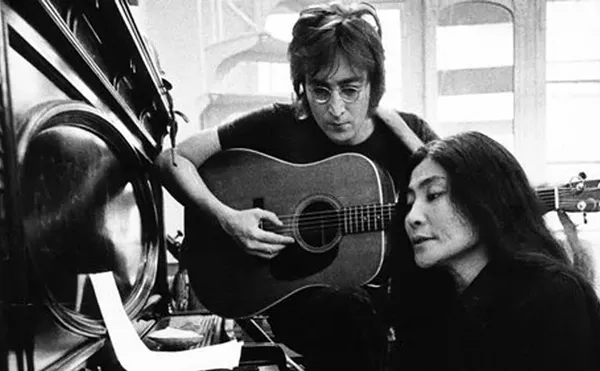A young woman lifts her chin to the ceiling as she holds a lit red candle between her teeth. The flame’s reflection is a tiny white dot in the solitary eye of her profile.
Although "Jen with a Candle in Her Mouth" is one of Richard Kern’s color photographs, its limited range of yellows, muted reds and dark browns isn’t the work of a colorist or an aesthete. Instead, there’s something like trouble in this tarnished glimpse of eccentricity, as if Kern is bringing us into a world of questionable practices, unsightly fixations.
Camera, the Latin word for "room," suggests the idea of photography taking place behind closed doors, in the privacy of someone’s obsessions. In Kern’s images, that transgressive sense of the camera is totally appropriate. There are naked young women here doing things not for prime-time viewing: biting their own toes, drooling creamy saliva as they brush their teeth, hefting guns that could be toys, or are they?
In "Jen with a Gun and a Dick," the same candle-biting model stands wearing a policeman’s hat, heavy makeup, black stockings and a blue shirt pulled open to expose her breasts and a huge strap-on dildo that she grips with determination. Her other hand is wrapped around a revolver that she holds at arm’s length, her face a strange mix of playtime bravado and mean pleasure. That the gun and the fake dick both point off camera in the same direction seems to give them a common purpose: bang bang, shoot shoot.
The "cheesecake" ancestors of these images – in which demure, semiclad cuties of the ’40s and ’50s intercepted the gazes of naughty boys peeking at their unmentionables – can’t hold a candle to Kern’s wild subjects. For one thing, there’s an unheard-of sense in Kern’s models that they are in charge. Demetrio Paparoni, who wrote the introduction to this book, calls it "their ability to dominate the scene." The fetishism, bondage, narcissism and mild self-abuse enacted by these women are as if ripped out of the controlling gaze of the photographer and reinserted in another context: "Whose imaginary is this, anyway?"
Kern, like certain photographers of Eros before him – Paul Outerbridge and Helmut Newton are the most obvious connections here – plays both ends against the middle, with tender inside and brash outside joining up in each shot. By publishing these painfully arousing works, he opens the private stance of the auto-erotic to public viewing. And adds his gesture to the collective riot of exhibitionism that seems to have taken over the art world and mass media in the ’90s.
In "Anna on Floor with Ropes," an aggressively unapologetic creature of desire, crawling toward the camera on all fours – in thigh-high boots and long leather gloves – and surrounded by coils of white rope, makes her intentions perfectly clear. Kern washes the scene with light, but leaves her eyes and mouth in semidarkness, a kind of somber reflection of her unchained spirit.
French glamour photographer Bettina Rheims, renowned for her rapport with female models, often achieves a kind of sisterhood of the spectacle in which the needs of the fashion industry are fulfilled alongside the demands of personal, erotic truth. Kern, in contrast, seems to translate his own phantasms into the "I just don’t give a fuck" stares of "Lisa Looking Through Her Legs," "Linda on a Ball," "Jen with a Gun and Bullet" and "Anna Wrapped in Rubber."
There’s a man’s sensibility in these pictures, no doubt. But it’s a mind set haunted by attitudes that seem to come from beyond itself, from the unconscious of his models. It’s as if Kern’s red- or green-toned setups are portraits of the raging-but-true inner sanctum of each model’s libido.
And his own desire is a transmitter receiving and sending their secret messages in a risky code that anyone can read given the chance.






